2005 SUBARU FORESTER differential
[x] Cancel search: differentialPage 258 of 477

7-1
7
Starting and operating
Fuel ................................................................ 7-2 Fuel requirements ............................................. 7-2
Fuel filler lid and cap ........................................ 7-4
State emission testing (U.S. only) ............... 7-7
Preparing to drive ......................................... 7-9
Starting the engine ....................................... 7-9 Manual transmission vehicle ........................... 7-9
Automatic transmission vehicle ...................... 7-10
Stopping the engine ..................................... 7-12
Manual transmission .................................... 7-12 Shifting speeds ................................................. 7-13
Driving tips ........................................................ 7-14
Automatic transmission ............................... 7-15 Selector lever for automatic transmission ..... 7-16
Shift lock release .............................................. 7-20
Rear viscous limited slip differential (LSD) (if equipped) .................................... 7-21
Power steering .............................................. 7-21
Braking .......................................................... 7-22 Braking tips ....................................................... 7-22
Brake system ..................................................... 7-22
Disc brake pad wear warning indicators ........ 7-23
ABS (Anti-lock Brake System) .................... 7-23 ABS system self-check .................................... 7-24
ABS warning light ............................................. 7-24
Electronic Brake Force Distribution (EBD) system (if equipped) ...................... 7-26Steps to take if EBD system fails .................... 7-26 Vehicle Dynamics Control system
(if equipped) ............................................... 7-28Vehicle Dynamics Control system monitor .... 7-30
Vehicle Dynamics Control OFF switch ........... 7-33
Parking your vehicle ..................................... 7-34 Parking brake .................................................... 7-34
Parking tips ....................................................... 7-34
Hill holder (for manual transmission – if equipped) ................................................ 7-36
Cruise control (if equipped) ......................... 7-38 To set cruise control ........................................ 7-38
To temporarily cancel the cruise control ....... 7-40
To turn off the cruise control ........................... 7-41
To change the cruising speed ......................... 7-41
Self-leveling rear suspension (if equipped) ............................................... 7-43
Page 278 of 477
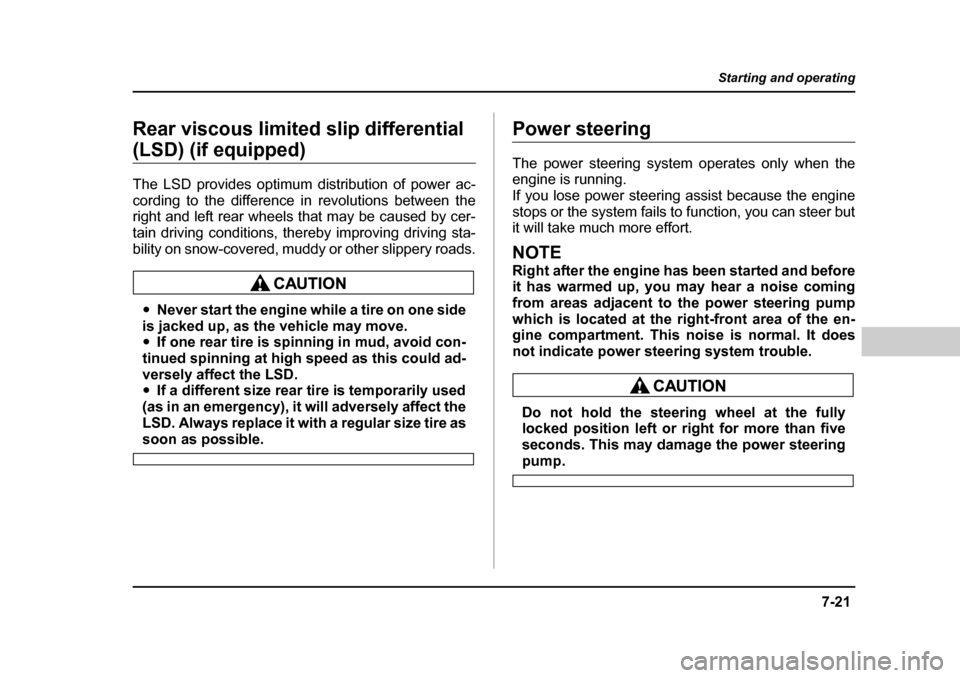
7-21
Starting and operating
– CONTINUED –
Rear viscous limited slip differential
(LSD) (if equipped)
The LSD provides optimum distribution of power ac-
cording to the difference in revolutions between the
right and left rear wheels that may be caused by cer-
tain driving conditions, thereby improving driving sta-
bility on snow-covered, muddy or other slippery roads.
�yNever start the engine while a tire on one side
is jacked up, as the vehicle may move. �y If one rear tire is spinning in mud, avoid con-
tinued spinning at high speed as this could ad-
versely affect the LSD.�y If a different size rear tire is temporarily used
(as in an emergency), it will adversely affect the
LSD. Always replace it with a regular size tire as
soon as possible.
Power steering
The power steering system operates only when the
engine is running.
If you lose power steering assist because the engine
stops or the system fails to function, you can steer but
it will take much more effort.
NOTE
Right after the engine has been started and before
it has warmed up, you may hear a noise coming
from areas adjacent to the power steering pump
which is located at the right-front area of the en-
gine compartment. This noise is normal. It does
not indicate power steering system trouble.
Do not hold the steering wheel at the fully
locked position left or right for more than five
seconds. This may damage the power steering
pump.
Page 327 of 477
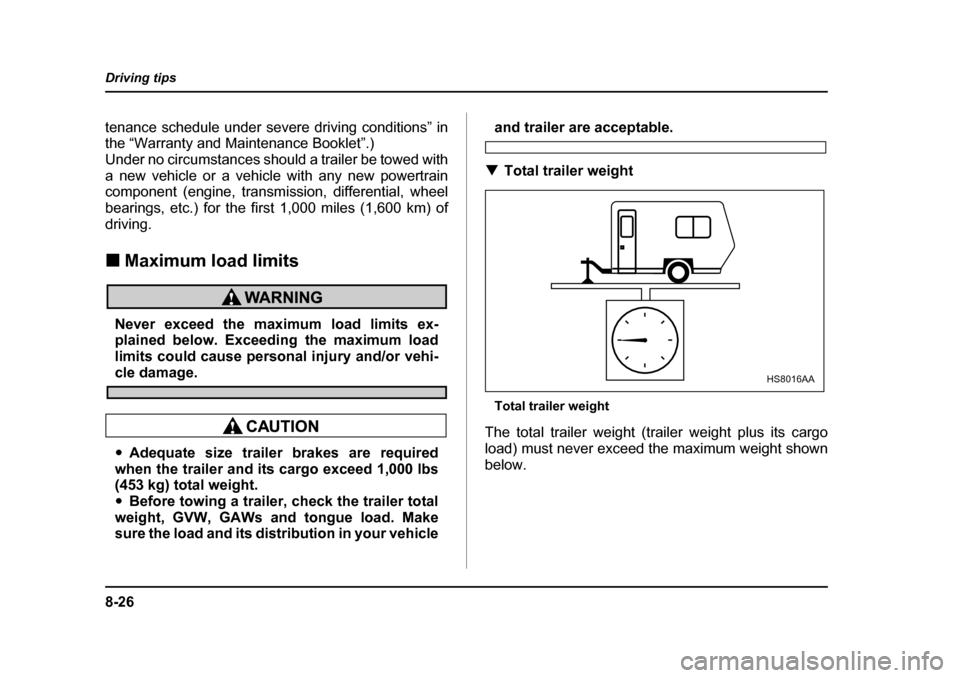
8-26
Driving tips
tenance schedule under severe driving conditions” in
the “Warranty and Maintenance Booklet”.)
Under no circumstances should a trailer be towed with
a new vehicle or a vehicle with any new powertrain
component (engine, transmission, differential, wheel
bearings, etc.) for the first 1,000 miles (1,600 km) of
driving. �„
Maximum load limits
Never exceed the maximum load limits ex-
plained below. Exceeding the maximum load
limits could cause personal injury and/or vehi-
cle damage.
�yAdequate size trailer brakes are required
when the trailer and its cargo exceed 1,000 lbs
(453 kg) total weight. �y Before towing a trailer, check the trailer total
weight, GVW, GAWs and tongue load. Make
sure the load and its distribution in your vehicle
and trailer are acceptable.
�T Total trailer weight
Total trailer weight
The total trailer weight (trailer weight plus its cargo
load) must never exceed the maximum weight shown
below.
HS8016AA
Page 350 of 477
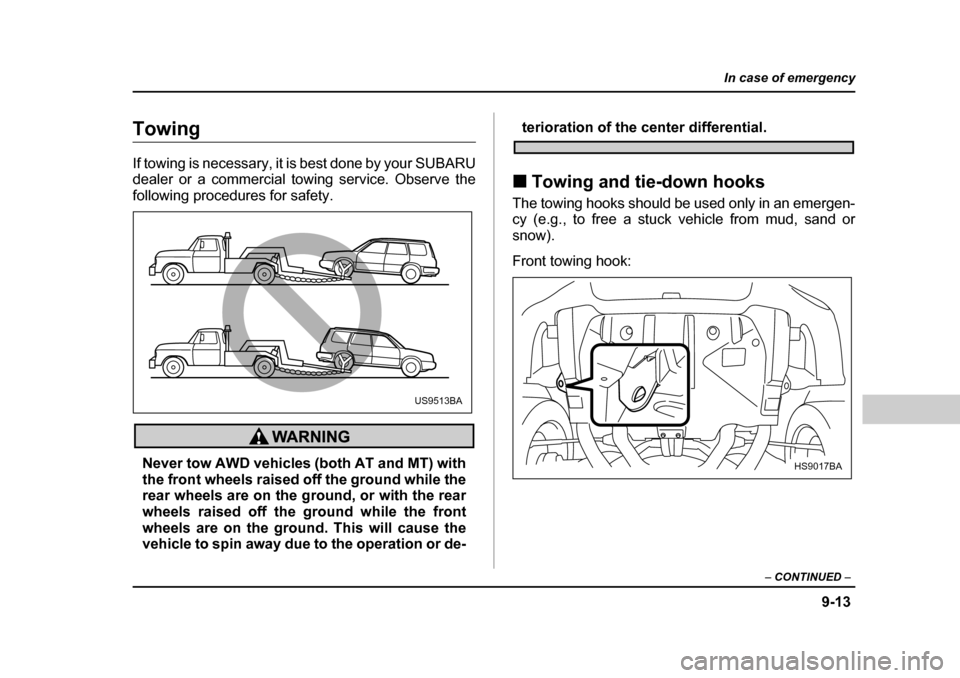
9-13
In case of emergency
– CONTINUED –
Towing If towing is necessary, it is best done by your SUBARU
dealer or a commercial towing service. Observe the
following procedures for safety.
Never tow AWD vehicles (both AT and MT) with
the front wheels raised off the ground while the
rear wheels are on the ground, or with the rear
wheels raised off the ground while the front
wheels are on the ground. This will cause the
vehicle to spin away due to the operation or de-
terioration of the center differential.
�„ Towing and tie-down hooks
The towing hooks should be used only in an emergen-
cy (e.g., to free a stuck vehicle from mud, sand orsnow).
Front towing hook:
US9513BA
HS9017BA
Page 352 of 477
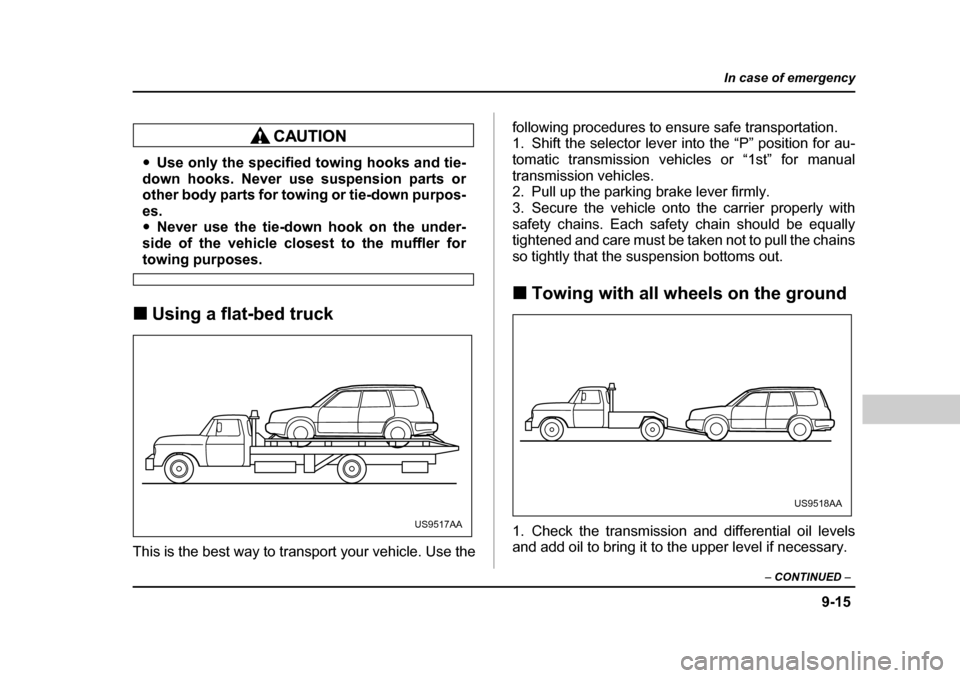
9-15
In case of emergency
– CONTINUED –
�yUse only the specified towing hooks and tie-
down hooks. Never use suspension parts or
other body parts for towing or tie-down purpos-
es.�y Never use the tie-down hook on the under-
side of the vehicle closest to the muffler for
towing purposes.
�„ Using a flat-bed truck
This is the best way to transport your vehicle. Use the following procedures to ensure safe transportation.
1. Shift the selector lever into the “P” position for au-
tomatic transmission vehicles or “1st” for manual transmission vehicles.
2. Pull up the parking brake lever firmly.
3. Secure the vehicle onto the carrier properly with
safety chains. Each safety chain should be equally
tightened and care must be taken not to pull the chains
so tightly that the suspension bottoms out. �„
Towing with all wheels on the ground
1. Check the transmission and differential oil levels
and add oil to bring it to the upper level if necessary.
US9517AA
US9518AA
Page 366 of 477

11 - 1
11
Maintenance and service
Maintenance schedule ................................. 11-3
Maintenance precautions ............................ 11-3 Before checking or servicing in the engine compartment .................................................. 11-4
When you do checking or servicing in the engine compartment while the engine is
running ............................................................ 11-5
Engine hood .................................................. 11-5
Engine compartment overview ................... 11-8 Non-turbo models ............................................. 11-8
Turbo models .................................................... 11-9
Engine oil ...................................................... 11-10 Checking the oil level ....................................... 11-10
Changing the oil and oil filter .......................... 11-11
Recommended grade and viscosity ................ 11-13
Recommended grade and viscosity under severe driving conditions .............................. 11-15
Synthetic oil ....................................................... 11-15
Cooling system ............................................. 11-16 Cooling fan, hose and connections ................ 11-16
Engine coolant .................................................. 11-17
Air cleaner element ...................................... 11-21 Replacing the air cleaner element ................... 11-21
Spark plugs ................................................... 11-25 Recommended spark plugs ............................. 11-26
Drive belts ..................................................... 11-26
Manual transmission oil ............................... 11-27 Checking the oil level ....................................... 11-27
Recommended grade and viscosity ................ 11-28 Automatic transmission fluid ...................... 11-29
Checking the fluid level .................................... 11-29
Recommended fluid ......................................... 11-31
Front differential gear oil (AT vehicles) ...... 11-31 Checking the oil level ....................................... 11-31
Recommended grade and viscosity ............... 11-32
Rear differential gear oil ............................... 11-33 Checking the gear oil level .............................. 11-33
Recommended grade and viscosity ............... 11-34
Power steering fluid ...................................... 11-34 Checking the fluid level .................................... 11-34
Recommended fluid ......................................... 11-35
Brake fluid ..................................................... 11-36 Checking the fluid level .................................... 11-36
Recommended brake fluid ............................... 11-36
Clutch fluid (MT vehicles) ............................ 11-37 Checking the fluid level .................................... 11-37
Recommended clutch fluid .............................. 11-37
Brake booster ................................................ 11-38
Brake pedal .................................................... 11-38 Checking the brake pedal free play ................ 11-38
Checking the brake pedal reserve distance ... 11-39
Clutch pedal (MT vehicles) ........................... 11-39 Checking the clutch function .......................... 11-39
Checking the clutch pedal free play ............... 11-40
Hill holder (MT vehicles – if equipped) ....... 11-40
Replacement of brake pad and lining ......... 11-41 Breaking-in of new brake pads and linings .... 11-41
Parking brake stroke .................................... 11-42
Page 396 of 477

11 -3 1
Maintenance and service
– CONTINUED –
fluid up to the upper level. Be careful not to overfill. �„Recommended fluid
“Dexron III” Type Automatic Transmission Fluid Front differential gear oil (AT vehi-
cles) �„
Checking the oil level
A) Yellow handle
Check the differential oil level monthly.
1. Park the vehicle on a level surface and stop the en-
gine.
2. Pull out the dipstick, wipe it clean, and insert it
again.
HSB018FC
A
Page 398 of 477
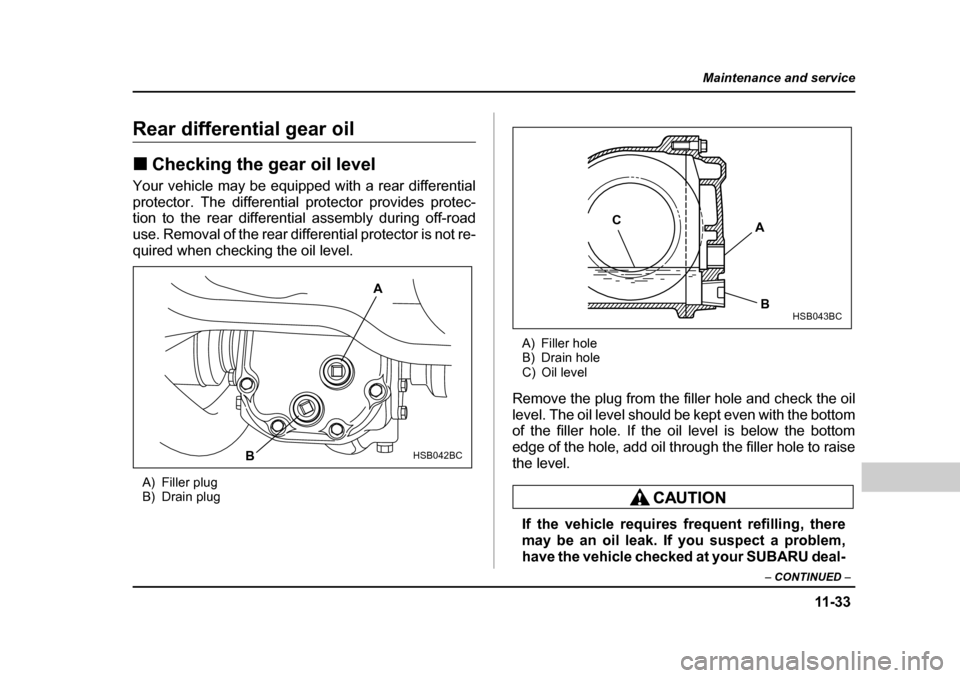
11 -3 3
Maintenance and service
– CONTINUED –
Rear differential gear oil �„Checking the gear oil level
Your vehicle may be equipped with a rear differential
protector. The differential protector provides protec-
tion to the rear differential assembly during off-road
use. Removal of the rear differential protector is not re-
quired when checking the oil level.
A) Filler plug
B) Drain plug A) Filler hole
B) Drain hole
C) Oil level
Remove the plug from the filler hole and check the oil
level. The oil level should be kept even with the bottom
of the filler hole. If the oil level is below the bottom
edge of the hole, add oil through the filler hole to raise
the level.
If the vehicle requires frequent refilling, there
may be an oil leak. If you suspect a problem,
have the vehicle checked at your SUBARU deal-
B AHSB042BC
C
A
B
HSB043BC